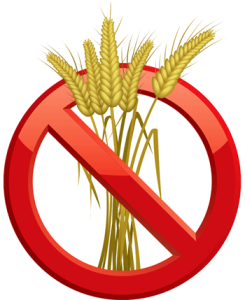
 Celiac disease
Celiac disease
Celiac disease is a digestive disorder. It is caused by an immune reaction to gluten. Celiac disease is also known as:
- sprue
- nontropical sprue
- gluten intolerance
- gluten-sensitive enteropathy
Gluten is a protein found in foods made with wheat, barley, rye, and triticale. It is also found in oats that have been processed in plants that handle other grains. Gluten can be found in some medicines, vitamins, and lipsticks.
In celiac disease, the immune reaction to gluten creates toxins. These damage the villi, which are tiny finger-like protrusions inside the small intestines. Damage to them decreases the body’s ability to absorb nutrients. This leads to malnutrition.
Treating celiac disease basically means eliminating all dietary gluten. This means avoiding most bread products, cakes and cookies, beer, and even products like ice cream where gluten is sometimes used as a stabilizing ingredient.
Risk Factors for Celiac Disease
Celiac disease runs in families. Family members of a person with celiac have a one in 22 risk of the disease. In the United States, the general population risk is one in 133.
People suffering from other immune diseases and certain genetic disorders are more likely to have celiac disease. Some disorders associated with celiac include:
- rheumatoid arthritis
- type 1 diabetes
- thyroid disease
- autoimmune liver disease
- Addison’s disease
- Sjogren’s disease
- lupus
- Down syndrome
- Turner syndrome
- lactose intolerance
- intestinal cancer
- intestinal lymphoma
Symptoms: Recognizing Celiac Disease
Symptoms of celiac disease can involve the intestines and digestive system, but can also affect other parts of the body. Children and adults tend to have a different set of symptoms.
Symptoms in Children
Children with celiac disease can be emotionally irritable. They tend to be smaller than normal and have delayed puberty. They may have enamel defects in their permanent teeth. Other symptoms include:
- weight loss
- vomiting
- abdominal bloating
- abdominal pain
- persistent diarrhea
- pale, fatty, foul-smelling stools
Symptoms in Adults
Adults with celiac disease have fewer abdominal symptoms. Symptoms are more related to other organs. They include:
- iron deficiency anemia
- arthritis
- bone and joint pain
- osteoporosis and bone fractures
- fatigue
- numbness and tingling in the hands and feet
- seizures
- canker sores in the mouth
- irregular menstrual periods
- infertility and miscarriage
Dermatitis herpetiformis (DH) is another symptom of celiac disease. DH is an intensely itchy, blistering skin rash. It occurs on the elbows, buttocks, and knees. Up to one quarter of people with celiac disease have DH. Those who do usually don’t have digestive symptoms.
Whether or not a person was breast-fed can affect the onset of symptoms—longer breastfeeding, for example, can delay onset of symptoms.
Other factors that play a role in symptoms are duration of illness and the amount of gluten in the diet. When diagnosis is delayed, complications are more likely to occur.
Some people with celiac disease have no symptoms. However, they may still have long-term complications.
How Is Celiac Disease Diagnosed?
Diagnosis begins with a physical examination and a medical history.
People with celiac disease often have high levels of anti-endomysium (EMA) and anti-tissue transglutaminase (tTGA) antibodies. These can be detected with blood tests. Tests are most reliable if performed while gluten is still in the diet.
Other blood tests include:
- complete blood count (CBC)
- liver enzymes (transaminases)
- cholesterol, may be lower than normal
- clotting factors
- alkaline phosphatase, which can signal blood loss
- albumin
An upper endoscopy can also be used to test for celiac. A small tube called an endoscope is threaded through the mouth to the small intestines. It allows the doctor to examine the intestines and perform a biopsy. Then the doctor can look for damage to the villi.
In people with DH, a skin biopsy can also help doctors diagnose celiac. With a positive skin biopsy and blood tests, internal biopsy may not be necessary.
Treating Celiac Disease
Permanently removing gluten from the diet is the only treatment for celiac disease. This allows the intestinal villi to heal and improves absorption of nutrients.
We may recommend vitamins and mineral nutrients as supplements if you can’t get adequate nutrition from a gluten-free diet. For some people, a short course of steroids is needed.
Symptoms can improve within days of removing gluten from the diet. However, you should not stop eating gluten until your diagnosis is made. Removing gluten prematurely may cause test results to be incorrect.
Food Precautions for People With Celiac
Maintaining a gluten-free diet is not easy. Fortunately, more and more companies are making gluten free products. There are even gluten free breads and pastas available!
If you have celiac, it is important to know what food is safe to eat. Doctors at the Mayo Clinic have created a series of food guidelines for people with celiac.
Absolutely avoid food and drinks that contain these ingredients:
- wheat
- spelt (a kind of wheat)
- rye
- barley
- triticale
- bulgur
- durum
- farina
- graham flour
- semolina
The following grains and starches are gluten free:
- buckwheat
- corn
- amaranth
- arrowroot
- cornmeal
- flour made from rice, soy, corn, potatoes, and beans
- pure corn tortillas
- quinoa
- rice
- tapioca
These foods are gluten free and help to make a balanced diet:
- fresh meats, fish, and poultry that haven’t been breaded, coated, or marinated
- fruits
- most dairy products
- potatoes, including sweet potatoes
- rice
- vegetables
- wine, distilled liquors, ciders and spirits
The following foods should be avoided unless the label says they are gluten-free:
- beer
- bread
- cakes and pies
- candy
- cereals
- cookies
- crackers
- croutons
- gravies
- imitation meats or seafood
- oats
- pasta
- processed lunch meats
- salad dressings
- sauces (includes soy sauce)
- self-basting poultry
- soups
Related Articles

